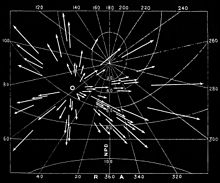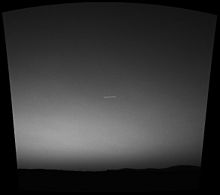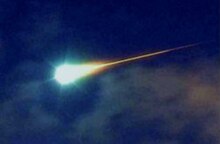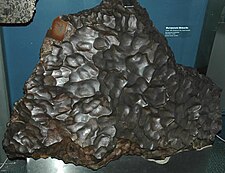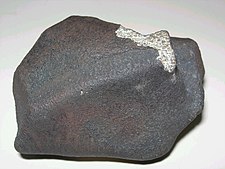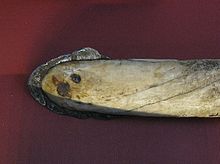From Wikipedia, the free encyclopedia
Meteorite

|
A
meteorite is a solid piece of debris from an object, such as a
comet,
asteroid, or
meteoroid, that originates in
outer space and survives its passage through the
atmosphere to reach the surface of a planet or
moon. When the object enters the atmosphere, various factors such as
friction,
pressure, and
chemical interactions with the atmospheric gases cause it to heat up and radiate that
energy. It then becomes a
meteor and forms a
fireball, also known as a
shooting star or
falling star; astronomers call the brightest examples "
bolides". Meteorites vary greatly in size. For geologists, a
bolide is a meteorite large enough to create an
impact crater.
Meteorites that are recovered after being observed as they transit the atmosphere and
impact the Earth are called
meteorite falls. All others are known as
meteorite finds. As of August 2018, there were about 1,412 witnessed falls that have specimens in the world's collections. As of 2018, there are more than 59,200 well-documented meteorite finds.
Meteorites have traditionally been divided into three broad categories: stony meteorites that are rocks, mainly composed of
silicate minerals;
iron meteorites
that are largely composed of metallic iron-nickel; and stony-iron
meteorites that contain large amounts of both metallic and rocky
material. Modern
classification
schemes divide meteorites into groups according to their structure,
chemical and isotopic composition and mineralogy. Meteorites smaller
than 2 mm are classified as
micrometeorites.
Extraterrestrial meteorites are such objects that have impacted other
celestial bodies, whether or not they have passed through an atmosphere.
They have been found on the
Moon and
Mars.
Naming
Meteorites are always named for the places they were found,
usually a nearby town or geographic feature. In cases where many
meteorites were found in one place, the name may be followed by a number
or letter (e.g., Allan Hills 84001 or Dimmitt (b)). The name designated
by the
Meteoritical Society is used by scientists, catalogers, and most collectors.
Fall phenomena
Most meteoroids disintegrate when entering the Earth's atmosphere.
Usually, five to ten a year are observed to fall and are subsequently
recovered and made known to scientists. Few meteorites are large enough to create large
impact craters. Instead, they typically arrive at the surface at their
terminal velocity and, at most, create a small pit.
The 'crater' made by a 61.9-gram Novato meteorite when it hit the roof of a house on October 17, 2012.
Large meteoroids may strike the earth with a significant fraction of their
escape velocity (second cosmic velocity), leaving behind a
hypervelocity
impact crater. The kind of crater will depend on the size, composition,
degree of fragmentation, and incoming angle of the impactor. The force
of such collisions has the potential to cause widespread destruction.
The most frequent hypervelocity cratering events on the Earth are
caused by iron meteoroids, which are most easily able to transit the
atmosphere intact. Examples of craters caused by iron meteoroids include
Barringer Meteor Crater,
Odessa Meteor Crater,
Wabar craters, and
Wolfe Creek crater;
iron meteorites are found in association with all of these craters. In
contrast, even relatively large stony or icy bodies like small
comets or
asteroids, up to millions of tons, are disrupted in the atmosphere, and do not make impact craters. Although such disruption events are uncommon, they can cause a considerable concussion to occur; the famed
Tunguska event
probably resulted from such an incident. Very large stony objects,
hundreds of meters in diameter or more, weighing tens of millions of
tons
or more, can reach the surface and cause large craters, but are very
rare. Such events are generally so energetic that the impactor is
completely destroyed, leaving no meteorites. (The very first example of a
stony meteorite found in association with a large impact crater, the
Morokweng crater in South Africa, was reported in May 2006.)
A bolide: a very bright meteor of an apparent magnitude of −14 or brighter. [DJS note: contradicts definition of bolide given above.]
Several phenomena are well documented during witnessed meteorite falls too small to produce hypervelocity craters.
The fireball that occurs as the meteoroid passes through the atmosphere
can appear to be very bright, rivaling the sun in intensity, although
most are far dimmer and may not even be noticed during daytime. Various
colors have been reported, including yellow, green, and red. Flashes and
bursts of light can occur as the object breaks up. Explosions,
detonations, and rumblings are often heard during meteorite falls, which
can be caused by
sonic booms as well as
shock waves
resulting from major fragmentation events. These sounds can be heard
over wide areas, with a radius of a hundred or more kilometers.
Whistling and hissing sounds are also sometimes heard, but are poorly
understood. Following passage of the fireball, it is not unusual for a
dust trail to linger in the atmosphere for several minutes.
NWA 859 iron meteorite showing effects of atmospheric ablation
As meteoroids are heated during
atmospheric entry, their surfaces melt and experience
ablation.
They can be sculpted into various shapes during this process, sometimes
resulting in shallow thumbprint-like indentations on their surfaces
called
regmaglypts.
If the meteoroid maintains a fixed orientation for some time, without
tumbling, it may develop a conical "nose cone" or "heat shield" shape.
As it decelerates, eventually the molten
surface layer solidifies into a thin fusion crust, which on most meteorites is black (on some
achondrites, the fusion crust may be very light colored). On stony meteorites, the
heat-affected zone
is at most a few mm deep; in iron meteorites, which are more thermally
conductive, the structure of the metal may be affected by heat up to 1
centimetre (0.39 in) below the surface. Reports vary; some meteorites
are reported to be "burning hot to the touch" upon landing, while others
are alleged to have been cold enough to condense water and form a
frost. Meteorites from multiple falls, such as Bjurbole,
Tagish Lake, and
Buzzard Coulee, have been found having fallen on lake and sea ice, perhaps suggesting that they were not hot when they fell.
Meteoroids that experience disruption in the atmosphere may fall
as meteorite showers, which can range from only a few up to thousands of
separate individuals. The area over which a meteorite shower falls is
known as its
strewn field. Strewn fields are commonly
elliptical
in shape, with the major axis parallel to the direction of flight. In
most cases, the largest meteorites in a shower are found farthest
down-range in the strewn field.
Meteorite types
Most meteorites are stony meteorites, classed as
chondrites and
achondrites. Only about 6% of meteorites are
iron meteorites or a blend of rock and metal, the
stony-iron meteorites. Modern classification of meteorites is complex. The review paper of Krot et al. (2007) summarizes modern meteorite taxonomy.
About 86% of the meteorites are chondrites, which are named for the small, round particles they contain. These particles, or
chondrules,
are composed mostly of silicate minerals that appear to have been
melted while they were free-floating objects in space. Certain types of
chondrites also contain small amounts of
organic matter, including
amino acids, and
presolar grains. Chondrites are typically about 4.55 billion years old and are thought to represent material from the
asteroid belt that never coalesced into large bodies. Like
comets,
chondritic asteroids are some of the oldest and most primitive
materials in the solar system. Chondrites are often considered to be
"the building blocks of the planets".
About 8% of the meteorites are
achondrites (meaning they do not contain chondrules), some of which are similar to terrestrial
igneous rocks.
Most achondrites are also ancient rocks, and are thought to represent
crustal material of differentiated planetesimals. One large family of
achondrites (the
HED meteorites) may have originated on the parent body of the
Vesta Family, although this claim is disputed.
Others derive from unidentified asteroids. Two small groups of
achondrites are special, as they are younger and do not appear to come
from the asteroid belt. One of these groups comes from the Moon, and
includes rocks similar to those brought back to Earth by
Apollo and
Luna programs. The other group is almost certainly from
Mars and constitutes the only materials from other planets ever recovered by humans.
About 5% of meteorites that have been seen to fall are
iron meteorites composed of iron-
nickel alloys, such as
kamacite and/or
taenite.
Most iron meteorites are thought to come from the cores of
planetesimals that were once molten. As with the Earth, the denser metal
separated from silicate material and sank toward the center of the
planetesimal, forming its core. After the planetesimal solidified, it
broke up in a collision with another planetesimal. Due to the low
abundance of iron meteorites in collection areas such as Antarctica,
where most of the meteoric material that has fallen can be recovered, it
is possible that the percentage of iron-meteorite falls is lower than
5%. This would be explained by a recovery bias; laypeople are more
likely to notice and recover solid masses of metal than most other
meteorite types. The abundance of iron meteorites relative to total
Antarctic finds is 0.4%.
Stony-iron meteorites constitute the remaining 1%. They are a mixture of iron-nickel metal and
silicate minerals. One type, called
pallasites,
is thought to have originated in the boundary zone above the core
regions where iron meteorites originated. The other major type of
stony-iron meteorites is the
mesosiderites.
Tektites (from Greek
tektos,
molten) are not themselves meteorites, but are rather natural glass
objects up to a few centimeters in size that were formed—according to
most scientists—by the impacts of large meteorites on Earth's surface. A
few researchers have favored tektites originating from the
Moon as volcanic ejecta, but this theory has lost much of its support over the last few decades.
Meteorite chemistry
In March 2015, NASA scientists reported that, for the first time, complex
organic compounds found in
DNA and
RNA, including
uracil, cytosine and
thymine, have been formed in the laboratory under
outer space conditions, using starting chemicals, such as
pyrimidine, found in meteorites. Pyrimidine and
polycyclic aromatic hydrocarbons (PAHs) may have been formed in
red giants or in
interstellar dust and gas clouds, according to the scientists.
In January 2018, researchers found that 4.5 billion-year-old
meteorites found on Earth contained liquid water along with prebiotic
complex organic substances that may be ingredients for life.
Meteorite recovery
Falls
Car seat and muffler hit by the Benld meteorite in 1938, with the meteorite inset. An observed fall.
Most
meteorite falls
are recovered on the basis of eyewitness accounts of the fireball or
the impact of the object on the ground, or both. Therefore, despite the
fact that meteorites fall with virtually equal probability everywhere on
Earth, verified meteorite falls tend to be concentrated in areas with
high
human population densities such as Europe, Japan, and
northern India.
A small number of meteorite falls have been observed with
automated cameras and recovered following calculation of the impact
point. The first of these was the
Přibram meteorite, which fell in
Czechoslovakia (now the Czech Republic) in 1959. In this case, two cameras used to photograph
meteors
captured images of the fireball. The images were used both to determine
the location of the stones on the ground and, more significantly, to
calculate for the first time an accurate orbit for a recovered
meteorite.
Following the Pribram fall, other nations established automated
observing programs aimed at studying infalling meteorites. One of these
was the
Prairie Network, operated by the
Smithsonian Astrophysical Observatory from 1963 to 1975 in the
midwestern US. This program also observed a meteorite fall, the
Lost City chondrite, allowing its recovery and a calculation of its orbit.
Another program in Canada, the Meteorite Observation and Recovery
Project, ran from 1971 to 1985. It too recovered a single meteorite,
Innisfree, in 1977. Finally, observations by the
European Fireball Network, a descendant of the original Czech program that recovered Pribram, led to the discovery and orbit calculations for the
Neuschwanstein meteorite in 2002.
NASA has an automated system that detects meteors and calculates the orbit, magnitude,
ground track, and other parameters over the southeast USA, which often detects a number of events each night.
Finds
Until the twentieth century, only a few hundred meteorite finds had
ever been discovered. More than 80% of these were iron and stony-iron
meteorites, which are easily distinguished from local rocks. To this
day, few stony meteorites are reported each year that can be considered
to be "accidental" finds. The reason there are now more than 30,000
meteorite finds in the world's collections started with the discovery by
Harvey H. Nininger that meteorites are much more common on the surface of the Earth than was previously thought.
The Great Plains of the US
Nininger's strategy was to search for meteorites in the
Great Plains
of the United States, where the land was largely cultivated and the
soil contained few rocks. Between the late 1920s and the 1950s, he
traveled across the region, educating local people about what meteorites
looked like and what to do if they thought they had found one, for
example, in the course of clearing a field. The result was the discovery
of over 200 new meteorites, mostly stony types.
In the late 1960s,
Roosevelt County, New Mexico
in the Great Plains was found to be a particularly good place to find
meteorites. After the discovery of a few meteorites in 1967, a public
awareness campaign resulted in the finding of nearly 100 new specimens
in the next few years, with many being by a single person, Ivan Wilson.
In total, nearly 140 meteorites were found in the region since 1967. In
the area of the finds, the ground was originally covered by a shallow,
loose soil sitting atop a
hardpan layer. During the
dustbowl era, the loose soil was blown off, leaving any rocks and meteorites that were present stranded on the exposed surface.
Antarctica
A scanning electron microscope revealed structures resembling bacteria fossils - in the meteorite ALH84001
discovered in Antarctica in 1984. Microscopically, the features were
initially interpreted as fossils of bacteria-like lifeforms. It has
since been shown that similar magnetite structures can form without the presence of microbial life in hydrothermal systems.
A few meteorites were found in
Antarctica between 1912 and 1964. In 1969, the 10th Japanese Antarctic Research Expedition found nine meteorites on a
blue ice field near the
Yamato Mountains. With this discovery, came the realization that movement of
ice sheets might act to concentrate meteorites in certain areas.
After a dozen other specimens were found in the same place in 1973, a
Japanese expedition was launched in 1974 dedicated to the search for
meteorites. This team recovered nearly 700 meteorites.
Shortly thereafter, the United States began its own program to search for Antarctic meteorites, operating along the
Transantarctic Mountains on the other side of the continent: the Antarctic Search for Meteorites (
ANSMET)
program. European teams, starting with a consortium called "EUROMET" in
the late 1980s, and continuing with a program by the Italian Programma
Nazionale di Ricerche in Antartide have also conducted systematic
searches for Antarctic meteorites.
The Antarctic Scientific Exploration of China has conducted
successful meteorite searches since 2000. A Korean program (KOREAMET)
was launched in 2007 and has collected a few meteorites.
The combined efforts of all of these expeditions have produced more
than 23,000 classified meteorite specimens since 1974, with thousands
more that have not yet been classified. For more information see the
article by Harvey (2003).
Australia
At
about the same time as meteorite concentrations were being discovered in
the cold desert of Antarctica, collectors discovered that many
meteorites could also be found in the hot
deserts of Australia. Several dozen meteorites had already been found in the
Nullarbor region of
Western and
South Australia. Systematic searches between about 1971 and the present recovered more than 500 others,
~300 of which are currently well characterized. The meteorites can be
found in this region because the land presents a flat, featureless,
plain covered by
limestone. In the extremely arid climate, there has been relatively little
weathering or
sedimentation
on the surface for tens of thousands of years, allowing meteorites to
accumulate without being buried or destroyed. The dark colored
meteorites can then be recognized among the very different looking
limestone pebbles and rocks.
The Sahara

In 1986–87, a German team installing a network of seismic stations
while prospecting for oil discovered about 65 meteorites on a flat,
desert plain about 100 kilometres (62 mi) southeast of Dirj (Daraj),
Libya.
A few years later, a desert enthusiast saw photographs of meteorites
being recovered by scientists in Antarctica, and thought that he had
seen similar occurrences in
northern Africa.
In 1989, he recovered about 100 meteorites from several distinct
locations in Libya and Algeria. Over the next several years, he and
others who followed found at least 400 more meteorites. The find
locations were generally in regions known as
regs or
hamadas: flat, featureless areas covered only by small pebbles and minor amounts of sand. Dark-colored meteorites can be easily spotted in these places. In the case of several meteorite fields, such as
Dar el Gani, Dhofar, and others, favorable light-colored geology consisting of
basic rocks (clays,
dolomites, and
limestones) makes meteorites particularly easy to identify.
Although meteorites had been sold commercially and collected by
hobbyists for many decades, up to the time of the Saharan finds of the
late 1980s and early 1990s, most meteorites were deposited in or
purchased by museums and similar institutions where they were exhibited
and made available for
scientific research.
The sudden availability of large numbers of meteorites that could be
found with relative ease in places that were readily accessible
(especially compared to Antarctica), led to a rapid rise in commercial
collection of meteorites. This process was accelerated when, in 1997,
meteorites coming from both the Moon and Mars were found in Libya. By
the late 1990s, private meteorite-collecting expeditions had been
launched throughout the Sahara. Specimens of the meteorites recovered in
this way are still deposited in research collections, but most of the
material is sold to private collectors. These expeditions have now
brought the total number of well-described meteorites found in Algeria
and Libya to more than 500.
Northwest Africa
Meteorite markets came into existence in the late 1990s, especially in
Morocco.
This trade was driven by Western commercialization and an increasing
number of collectors. The meteorites were supplied by nomads and local
people who combed the deserts looking for specimens to sell. Many
thousands of meteorites have been distributed in this way, most of which
lack any information about how, when, or where they were discovered.
These are the so-called "Northwest Africa" meteorites. When they get
classified, they are named "Northwest Africa" (abbreviated NWA) followed
by a number.
It is generally accepted that NWA meteorites originate in Morocco,
Algeria, Western Sahara, Mali, and possibly even further afield. Nearly
all of these meteorites leave Africa through Morocco. Scores of
important meteorites, including Lunar and Martian ones, have been
discovered and made available to science via this route. A few of the
more notable meteorites recovered include
Tissint and
Northwest Africa 7034.
Tissint was the first witnessed Martian meteorite fall in over fifty
years; NWA 7034 is the oldest meteorite known to come from Mars, and is a
unique water-bearing regolith breccia.
Arabian Peninsula
In 1999, meteorite hunters discovered that the desert in southern and central
Oman were also favorable for the collection of many specimens. The gravel plains in the
Dhofar and
Al Wusta regions of Oman, south of the sandy deserts of the
Rub' al Khali, had yielded about 5,000 meteorites as of mid-2009. Included among these are a large number of
lunar and
Martian
meteorites, making Oman a particularly important area both for
scientists and collectors. Early expeditions to Oman were mainly done by
commercial meteorite dealers, however international teams of Omani and
European scientists have also now collected specimens.
The recovery of meteorites from Oman is currently prohibited by
national law, but a number of international hunters continue to remove
specimens now deemed national treasures. This new law provoked a small
international incident,
as its implementation preceded any public notification of such a law,
resulting in the prolonged imprisonment of a large group of meteorite
hunters, primarily from Russia, but whose party also consisted of
members from the US as well as several other European countries.
The American Southwest
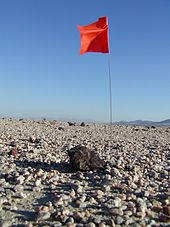
Beginning in the mid-1960s, amateur meteorite hunters began scouring the arid areas of the
southwestern United States. To date, meteorites numbering possibly into the thousands have been recovered from the
Mojave,
Sonoran,
Great Basin, and
Chihuahuan Deserts, with many being recovered on
dry lake beds. Significant finds include the three tonne
Old Woman meteorite, currently on display at the
Desert Discovery Center in
Barstow, California. Other rare finds include the Los Angeles meteorite, a Martian meteorite, Superior Valley 014 Acapulcoite, one of two of its type found within the United States, and the Blue Eagle meteorite, the first Rumuruti-type chondrite yet found in the Americas.
A number of finds from the American Southwest have yet to be formally
submitted to the Meteorite Nomenclature Committee, as many finders think
it is unwise to publicly state the coordinates of their discoveries for
fear of confiscation by the federal government and competition with
other hunters at published find sites.
Several of the meteorites found recently are currently on display in the
Griffith Observatory in Los Angeles.
Meteorites in history
Meteorite falls may have been the source of
cultish worship. The cult in the
Temple of Artemis at Ephesus, one of the
Seven Wonders of the Ancient World,
possibly originated with the observation and recovery of a meteorite
that was understood by contemporaries to have fallen to the earth from
Jupiter, the principal Roman deity.
There are reports that a sacred stone was enshrined at the temple that may have been a meteorite. The
Black Stone set into the wall of the
Kaaba has often been presumed to be a meteorite, but the little available evidence for this is inconclusive.
Although the use of the metal found in meteorites is also recorded in
myths of many countries and cultures where the celestial source was
often acknowledged, scientific documentation only began in the last few
centuries.
The oldest known iron artifacts are nine small beads hammered
from meteoritic iron. They were found in northern Egypt and have been
securely dated to 3200 BC.
In the 1970s, a stone meteorite was uncovered during an
archaeological dig at Danebury Iron Age hillfort, Danebury England. It
was found deposited part way down in an
Iron Age
pit (c. 1200 BC). Since it must have been deliberately placed there,
this could indicate one of the first (known) human finds of a meteorite
in Europe.
Some Native Americans treated meteorites as ceremonial objects. In 1915, a 61-kilogram (135 lb) iron meteorite was found in a
Sinagua (c. 1100–1200 AD) burial cyst near
Camp Verde, Arizona, respectfully wrapped in a feather cloth. A small pallasite was found in a pottery jar in an old burial found at
Pojoaque Pueblo,
New Mexico.
Nininger reports several other such instances, in the Southwest US and
elsewhere, such as the discovery of Native American beads of
meteoric iron found in Hopewell
burial mounds, and the discovery of the Winona meteorite in a Native American stone-walled crypt.
A lance made from a Narwhal tusk with a meteorite iron head
Indigenous peoples often prized iron-nickel meteorites as an easy, if limited, source of iron metal. For example, the Inuit used chips of the
Cape York meteorite to form cutting edges for tools and spear tips.
Two of the oldest recorded
meteorite falls in Europe are the
Elbogen (1400) and
Ensisheim (1492) meteorites. The German physicist,
Ernst Florens Chladni, was the first to publish (in 1794) the then audacious idea that meteorites were rocks from space. His booklet was
"On the Origin of the Iron Masses Found by Pallas and Others Similar to it, and on Some Associated Natural Phenomena".
In this he compiled all available data on several meteorite finds and
falls concluded that they must have their origins in outer space. The
scientific community of the time responded with resistance and mockery.
It took nearly ten years before a general acceptance of the origin of
meteorites was achieved through the work of the French scientist
Jean-Baptiste Biot and the British chemist,
Edward Howard. Biot's study, initiated by the
French Academy of Sciences, was compelled by a fall of
thousands of meteorites on 26 April 1803 from the skies of L'Aigle, France.
One of the leading
theories for the cause of the
Cretaceous–Paleogene extinction event that included the
dinosaurs is a large meteorite impact. The
Chicxulub Crater
has been identified as the site of this impact. There has been a lively
scientific debate as to whether other major extinctions, including the
ones at the end of the
Permian and
Triassic
periods might also have been the result of large impact events, but the
evidence is much less compelling than for the end Cretaceous
extinction.
There are several reported instances of falling meteorites having
killed people and livestock, but a few of these appear more credible
than others. The most infamous reported fatality from a meteorite impact
is that of an Egyptian dog that was killed in 1911, although this
report is highly disputed. This meteorite fall was identified in the
1980s as
Martian in origin. There is substantial evidence that the meteorite known as Valera (Venezuela 1972)
hit and killed a cow upon impact, nearly dividing the animal in two,
and similar unsubstantiated reports of a horse being struck and killed
by a stone of the New Concord fall also abound. Throughout history, many
first- and second-hand reports of meteorites falling on and killing
both humans and other animals abound. One example is from 1490 AD in
China, which purportedly killed thousands of people.
John Lewis has compiled some of these reports, and summarizes, "No one
in recorded history has ever been killed by a meteorite in the presence
of a meteoriticist and a medical doctor" and "reviewers who make
sweeping negative conclusions usually do not cite any of the primary
publications in which the eyewitnesses describe their experiences, and
give no evidence of having read them".
Another claim was put forth by a young boy who stated that he had been hit by a small (~3-
gram) stone of the Mbale meteorite fall from
Uganda,
and who stood to gain nothing from this assertion. The stone reportedly
fell through banana leaves before striking the boy on the head, causing
little to no pain, as it was small enough to have been slowed by both
friction with the atmosphere as well as that with banana leaves, before striking the boy.
Several persons have since claimed to have been struck by "meteorites" but no verifiable meteorites have resulted.
Meteorite weathering
Most meteorites date from the oldest times in the solar system and
are by far the oldest material available on the planet. Despite their
age, they are fairly vulnerable to terrestrial environment: water, salt,
and oxygen attack the meteorites as soon they reach the ground.
The terrestrial alteration of meteorites is called
weathering.
In order to quantify the degree of alteration that a meteorite
experienced, several qualitative weathering indices have been applied to
Antarctic and desertic samples.
The most known weathering scale, used for
ordinary chondrites, ranges from
W0 (pristine state) to
W6 (heavy alteration).
Fossil meteorites
"Fossil"
meteorites are sometimes discovered by geologists. They represent the
deeply weathered remains of meteorites that fell to Earth in the remote
past and were preserved in sedimentary deposits sufficiently well that
they can be recognized through mineralogical and geochemical studies.
One limestone quarry in Sweden has produced an anomalously large number
(more than a hundred) fossil meteorites from the
Ordovician,
nearly all of which are deeply weathered L-chondrites that still
resemble the original meteorite under a petrographic microscope, but
which have had their original material almost entirely replaced by
terrestrial secondary mineralization. The extraterrestrial provenance
was demonstrated in part through isotopic analysis of relict
spinel
grains, a mineral that is common in meteorites, is insoluble in water,
and is able to persist chemically unchanged in the terrestrial
weathering environment. One of these fossil meteorites, dubbed
Österplana 065, appears to represent a distinct type of meteorite that
is "extinct" in the sense that it is no longer falling to Earth, the
parent body having already been completely depleted from reservoir of
Near Earth Objects.
Notable meteorites
- Allende, largest known carbonaceous chondrite (Chihuahua, Mexico, 1969).
- Allan Hills A81005 – First meteorite determined to be of lunar origin.
- Allan Hills 84001 – Mars meteorite that was claimed to prove the existence of life on Mars.
- The Bacubirito Meteorite (Meteorito de Bacubirito) – A meteorite estimated to weigh 20–30 short tons (18–27 t). It is on display at the Centro de Ciencias de Sinaloa in Culiacán, Sinaloa, Mexico.
- Campo del Cielo – a group of iron meteorites associated with a crater field (of the same name) of at least 26 craters in West Chaco Province, Argentina. The total weight of meteorites recovered exceeds 100 tonnes.
- Canyon Diablo – Associated with Meteor Crater in Arizona.
- Cape York – One of the largest meteorites in the world. A 34-ton fragment called "Ahnighito", is exhibited at the American Museum of Natural History; the largest meteorite on exhibit in any museum.
- Gibeon – A large Iron meteorite in Namibia, created the largest known strewn field.
- Hoba – The largest known intact meteorite.
- Kaidun – An unusual carbonaceous chondrite.
- Murchison – A carbonaceous chondrite found to contain nucleobases – the building block of life.
- Nōgata – The oldest meteorite whose fall can be dated precisely (to 19 May 861, at Nōgata)
- Orgueil – A famous meteorite due to its especially primitive nature and high presolar grain content.
- Sikhote-Alin – Massive iron meteorite impact event that occurred on 12 February 1947.
- Tucson Ring – Ring shaped meteorite, used by a blacksmith as a table, in Tucson AZ. Currently at the Smithsonian.
- Willamette – The largest meteorite ever found in the United States.
- 2007 Carancas impact event
– On 15 September 2007, a stony meteorite that may have weighed as much
as 4000 kilograms created a crater 13 meters in diameter near the
village of Carancas, Peru.
- 2013 Russian meteor event — a 17-metre diameter, 10 000 ton asteroid hit the atmosphere above Chelyabinsk, Russia at 18 km/s around 09:20 local time (03:20 UTC) 15 February 2013, producing a very bright fireball in the morning sky. A number of small meteorite fragments have since been found nearby.
- Block Island meteorite and Heat Shield Rock – Discovered on Mars by Opportunity rover among four other iron meteorites. Two nickel-iron meteorites were identified by the Spirit rover.
Notable large impact craters
- Acraman crater in South Australia (90 kilometres (56 mi) diameter)
- Ames crater in Major County, Oklahoma 16 kilometres (9.9 mi) diameter
- Brent crater in northern Ontario (3.8 kilometres (2.4 mi) diameter)
- Chesapeake Bay impact crater (90 kilometres (56 mi) diameter)
- Chicxulub Crater off the coast of Yucatán Peninsula (170 kilometres (110 mi) diameter)
- Clearwater Lakes a double crater impact in Québec, Canada (26 and 36 kilometres (16 and 22 mi) in diameter)
- Lonar crater in India (1.83 kilometres (1.14 mi) diameter)
- Lumparn in the Åland Islands, in the Baltic Sea (9 kilometres (5.6 mi) diameter)
- Manicouagan Reservoir in Québec, Canada (100 kilometres (62 mi) diameter)
- Manson crater in Iowa (38 kilometres (24 mi) crater is buried)
- Meteor Crater in Arizona, also known as "Barringer Crater", the first confirmed terrestrial impact crater. (1.2 kilometres (0.75 mi) diameter)
- Mjølnir impact crater in the Barents Sea (40 kilometres (25 mi) diameter)
- Nördlinger Ries crater in Bavaria, Germany (25 kilometres (16 mi) diameter)
- Popigai crater in Russia (100 kilometres (62 mi) diameter)
- Siljan (lake) in Sweden, largest crater in Europe (52 kilometres (32 mi) diameter)
- Sudbury Basin in Ontario, Canada (250 kilometres (160 mi) diameter).
- Ungava Bay in Québec, Canada (260 by 320 kilometres (160 by 200 mi))
- Vredefort Crater
in South Africa, the largest known impact crater on Earth (300
kilometres (190 mi) diameter from an estimated 10 kilometres (6.2 mi)
wide meteorite).
Notable disintegrating meteoroids



